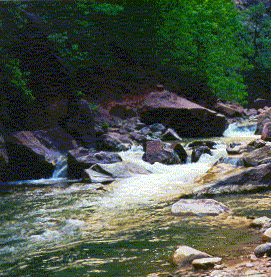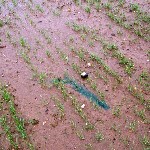Soil structure
Soil Structure
Soil structure refers to the arrangement of soil separates into units called soil aggregates. An aggregate
possesses solids and pore space. Aggregates are separated by planes of weakness and are dominated
by clay particles. Silt and fine sand particles may also be part of an aggregate. The aggregate acts like a
larger silt or sand particle depending upon its size.
The arrangement of soil aggregates into different forms gives a soil its structure. The natural processes
that aid in forming aggregates are:
1) wetting and drying,
2) freezing and thawing,
3) microbial activity that aids in the decay of organic matter,
4) activity of roots and soil animals, and
5) adsorbed cations.
The wetting/drying and freezing/thawing action as well as root or animal activity push particles back and forth to form aggregates.
Decaying plant residues and microbial byproducts coat soil particles and bind particles into aggregates.
Adsorbed cations help form aggregates whenever a cation is bonded to two or more particles.
Table 2.3. Structure type and description
Structure is one of the defining characteristics of a soil horizon. A soil exhibits only one structure per soil
horizon, but different horizons within a soil may exhibit different structures. All of the soil-forming factors,
especially climate, influence the type of structure that develops at each depth. Granular and crumb
structure are usually located at the soil surface in the A horizon. The subsoil, predominantly the B horizon,
has subangular blocky, blocky, columnar or prismatic structure. Platy structure can be found in the surface
or subsoil while single grain and structureless structure are most often associated with the C horizon. Turn
to Soils - Part 1 to identify the structure for different horizons of the Holdrege, Nora, Sharpsburg and
Valentine soils.
Aggregates are important in a soil because they influence bulk density, porosity and pore size. Pores within
an aggregate are quite small as compared to the pores between aggregates and between single soil
particles. This balance of large and small pores provides for good soil aeration, permeability and water-holding capacity.
Tillage, falling raindrops and compaction are primarily responsible for destroying aggregates. As the
cutting edge of a tillage implement is pulled through the soil, the shearing action at the point of contact
breaks apart aggregates. If tillage is conducted at the same depth for several years, a tillage pan may
develop. This is one form of compaction. Particles that were once part of the aggregates may reorient
themselves and form platy structures. The amount of aggregate destruction that results from tillage
depends on the amount of energy the tillage implement places in the soil. The field cultivator has little
down pressure and destroys few aggregates. The disk, however, has both cutting action because of the
rotation of the disk and shearing action. Together there is substantial down pressure and destruction.
Aggregates on the soil surface can be broken down by the beating action of raindrops. The single
particles that were once part of the aggregate can easily form a crust when the soil dries. The crust
looks very similar to the crust formed on a puddle after it rains. It is very difficult for water to infiltrate
a crust and for seedlings to push up through a crust. Thus, field operations that lead to aggregate
destruction at the soil surface have detrimental secondary effects. The particles also can be eroded if
they become detached by rainfall.
Compaction can lead to the breakdown of aggregates in the surface soil and subsoil if the applied force
from wheel traffic, animal traffic or human traffic is greater than the force holding an aggregate together.
Field observations have shown that compaction can cause granular structure on the soil surface to break
down and reform as blocky structure and blocky or subangular blocky structure in the subsoil to become
structureless.
Aggregation is promoted by root growth and the addition of organic material. Roots excrete compounds
that are used as food by microorganisms. Also, as roots absorb water and dry the soil, cracks form along
planes of weakness. Lastly, when roots decay, root channels serve as conduits for water that facilitate
wetting/drying and freezing/thawing.
Organic material may be added in the form of crop residue, animal manure, sludge, and green manure.
These additions are usually made to the surface soil and are critical to the development of granular and
crumb structure. As organic material is incorporated by tillage, soil animals and microorganisms, it aids in
subsoil structure development.



